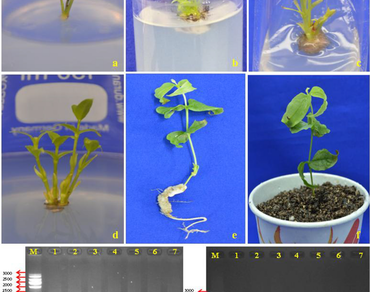An improved in vitro regeneration and assessment of genetic fidelity using ISSR markers in Strychnos potatorum L. f.
Research Articles | Published: 02 August, 2022
First Page: 661
Last Page: 667
Views: 3319
Keywords: In vitro, Nodal buds, 6-Benzylaminopurine, Naphthalene acetic acid, Clonal fidelity assessment
Abstract
The present study reports development of an improved in vitro regeneration protocol of Strychnos potatorum L. f. a wild threatened medicinal tree species. The higher rate of morphogenetic plant regeneration was observed in seedlings derived young nodal bud explants when compared to shoot tips explants. Nodal explants cultured on MS medium supplemented with 1.0 mg/L–1 6-benzylaminopurine (BAP) in combination with 0.5 mg/L–1 naphthalene acetic acid (NAA) induced a maximum number of shoots of (10.5 ± 0.53) with a mean shoot height of (5.2 ± 0.36 cm) was obtained. BAP was found more significant in multiple shoot induction when compared to other cytokinins used in this study. In vitro rooting was achieved on half-strength MS medium augmented with different concentrations of auxins. NAA at 0.5 mg/L–1 produced the highest number of healthy roots (8.6 ± 0.70). The rooted plantlets were successfully hardened in the paper cups containing farmyard manure and garden soil in 1:1 ratio and successfully transferred to field conditions. About 80% of the plants survived in the natural habitat. The field-grown plants showed similarity in its growth characteristics to their mother plant. An assessment of clonal fidelity of regenerated plants was undertaken using inter simple sequence repeat (ISSR) markers which revealed that they are monomorphic and more comparable to their mother plants. This efficient reproducible protocol can be useful for the production of true-to-type nature and ex situ conservation of this threatened S. potatorum tree species.

References
Ahmad A, Ahmad N, Anis M, Alatar AA, Salam EM, Qahtan AA, Faisal M (2020) Gibberellic acid and thidiazuron promote micropropagation of an endangered woody tree (Pterocarpus marsupium Roxb.) using in vitro seedlings. Plant Cell Tissue Org Cul 144:449–462
Ankita RP, Chew BL, Sreeramanan S (2021) Assessment of genetic stability on in vitro and ex vitro plants of Ficus carica var. black jack using ISSR and DAMD markers. Mol Biol Rep 48(11):7223–7231
Doyle JJ, Doyle JL (1987) A rapid DNA isolation procedure for small quantities of fresh leaf tissue. Phytochem Bull 19(1):11–15
Drury H (1873) The useful plants of India, 2nd edn. William H. Allen, London, pp 408–409
Isah T (2020) Nodal segment explant type and preconditioning influence in vitro shoot morphogenesis in Ginkgo biloba L. Plant Physiol Rep 25:74–86
Kagithoju S, Godishala V, Kairamkonda M, Nanna RS (2013) Embryo culture is an efficient way to conserve a medicinally important endangered forest tree species Strychnos potatorum. Fores Res 24(2):279–283
Khare CP (2007) Indian medicinal plants-an illustrated dictionary. First Indian reprint. Springer, New Delhi
Kirtikar KR, Basu BD (1918) Indian Medicinal Plants, Sudhindra Nath Basu, Panini Office: Bahadurganj, India, vol III, p 841–843
Lin J, Zou J, Zhang B, Que Q, Zhang J, Chen X, Zhou W (2021) An efficient in vitro propagation protocol for direct organogenesis from root explants of a multi-purpose plant, Broussonetia papyrifera (L.) L’Hér. ex Vent. Ind Crop Prod 170:113686
Malik SK, Chaudhury R, Kalia RK (2005) Rapid in vitro multiplication and conservation of Garcinia indica: a tropical medicinal tree species. Sci Hort 106:539–553
Manokari M, Priyadharshini S, Mahipal S, Shekhawat (2020) Micropropagation of sea grape (Coccoloba uvifera (L.) L.). S Afr J Bot 140:250–258
Mao AA, Vijayan D, Singha RKN, Pradhan S (2018) In vitro propagation of Rhododendron wattii Cowan-a critically endangered and endemic plant from India. In Vitro Cell Dev Biol Plant 54:45–53
Murashige T, Skoog F (1962) A revised medium for rapid growth and bioassays with tobacco tissue culture. Physiol Plant 15:473–497
Nowakowska K, Pacholczak A, Tepper W (2019) The effect of selected growth regulators and culture media on regeneration of Daphne mezereum L. ‘Alba.’ Rendiconti Lincei Scienze Fisiche e Naturali 30:197–205
Rai MK, Asthana P, Jaiswal VS, Jaiswal U (2010) Biotechnological advances in guava (Psidium guajava L.): recent developments and prospects for further research. Tree-Struct Funct 24:1–12
Saavedra AM, de Castro TC, da Silva Cordeiro L, Athayde T, Albarello N, Simoes Gurgel C (2021) In vitro propagation and cryopreservation of the medicinal species Hovenia dulcis Thunb. (Rhamnaceae). Plant Cell Tissue Org Cul 144(3):577–591
Sharma U, Kataria V, Shekhawat NS (2017) In vitro propagation, ex vitro rooting and leaf micro morphology of Bauhinia racemosa Lam.: a leguminous tree with medicinal values. Physiol Mol Biol Plants 23(4):969–977
Shekhawat MS, Manokari M, Revathi J (2017) In vitro propagation and ex vitro rooting of Aerva lanata (L.) Juss. Ex Schult.: a rare medicinal plant. Indian J Plant Physiol 22(1):40–47
Teeluck JM, Kaudeer BF, Ramful M, Boodhram I, Sanmukhiya MR, Soulange JG (2016) Genetic fidelity of in vitro propagated breadfruit (Artocarpus altilis) using inter simple sequence repeat markers. Int J Agric Biol 18:911–916
Yadav KN, Kadam PV, Patel JA, Patil MJ (2014) Strychnos potatorum phytochemical and pharmacological review. Pharmacogn Rev 8(15):61–66
Zafar N, Mujib A, Ali M, Tonk D, Gulzar B, Malik M, Sayeed R, Mamgain J (2019) Genome size analysis of field grown and tissue culture regenerated Rauvolfia serpentina (L) by flow cytometry: histology and scanning electron microscopic study for in vitro morphogenesis. Ind Crop Prod 128:545–555
Zhang A, Wang H, Shao Q, Xu M, Zhang W, Li M (2015) Large scale in vitro propagation of Anoectochilus roxburghii for commercial application: pharmaceutically important and ornamental plant. Ind Crop Prod 70:158–162
Author Information
Research Department of Botany, The Madura College (Autonomous), Madurai, India